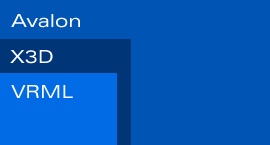Creating X3D Applications
Keywords:
IRViewer
Author(s): Johannes Behr
Date: 2007-11-10
Summary: This tutorial is the first in a group of tutorials which tries to teach how to develop VR/AR applications with the InstantReality Framework. This tutorial tries to explain some basics but is mainly a starting point to get you pushed into the right direction. These tutorials are no tutorials on VR/AR in general or developer tutorials for framework internals.
Relation to X3D
One goal of the Instant Player design was to make it really easy to write immersive VR and AR applications. One basic idea was, not to use a single GUI-Tool or method but a software abstraction layer which would allow us to define rich, dynamic and highly interactive content. Since there is no ISO/ANSI/whatever standard for such an VR/AR application-interface, we tried to adapt something which is well known, practical and very close to our domain: X3D.

The X3D standard is a royalty-free ISO standard file format and run-time architecture to represent and communicate 3D scenes and objects using XML. The standard itself is a successor of the VRML97 ISO standard. We utilized and extended this standard to fit the requirements we had from the VR/AR domain. This way our nodes and features are really a superset of X3D/VRML, and every X3D application is a valid Instant Player application.
X3D Sources to read
To get started you have at least to understand the basic concepts of VRML/X3D. The official web-page has the X3D spec online which is not what you would like to read in the beginning. The developer section on the Web3d page holds some interesting links to tutorials and software tools. If you prefer some text books you should check out the X3D Book from Don Brutzman and Leonard Daly. Sometimes you can find some interesting, possibly used and really cheap VRML books, like the "VRML Handbook" or e.g. "VRML - 3D-Welten im Internet".
X3D Basic Elements
After reading the X3D information you should be familiar with the concepts of Nodes, Fields, InSlots, OutSlots and Routes. Inside of the Instant Player system really everything (from the application programmers point of view) is described by nodes and node relations. In general a node is a component which is registered in a single namespace. The node has normally various relations to other node instances. Some relations describe the hierarchy of your scene (e.g. parents/ children), and other control mechanisms of the event flow (e.g. routes). VRML97 uses all those features in a single encoding with 54 nodes. X3D has more than 100 nodes and 3 encodings, whereas Instant Player has more than 400 nodes, 3 encodings and some further extensions.X3D Conformance
Most VRML/X3D files should work right away. If you have some files that do not perform right, please visit the forum or write us a mail including the file and/or a short description.
However, there are some known bugs and not yet implemented VRML/X3D features. The online documentation should list the state of every implementation.
Growing number of Nodes and Components
VRML was a static ISO standard which only defined a fixed set of 54 nodes. X3D almost doubled this number in the first version and indroduced Components and Profiles to group and organize all nodes. X3D, in contrast to VRML, was designed to be extensible and therefore people keep revising the standard or build application specific node-sets like we did. If you look at the documentation you can see how the node-sets were growing over time from VRML 2.0, X3D 3.0, X3D 3.1 up to X3D 3.2. In addition to the nodes new components (e.g. for shaders) where also introduced.
Mimetypes and encodings
X3D supports not just a single data encoding but three in order to fulfill different application requirements. First of all there is an XML based encoding, which is easy to read and write for humans as well as for computers.
Code: XML Encoding, mimetype: model/x3d+xml, file-suffix: x3d
<?xml version="1.0" encoding="UTF-8"?>
<X3D profile='Immersive'>
<Scene>
<Shape>
<Text string="Hello world!" />
</Shape>
</Scene>
</X3D>The VRML syntax has some disadvantages concerning parsing and the like. However for historical reasons the VRML encoding is still supported in X3D as the so-called classic encoding:
Code: Classic Encoding, mimetype: model/x3d+vrml, file-suffix: x3dv,wrl
#X3D 3.0 utf8
Shape {
geometry Text {
string "Hello, World"
}
}
The binary format can be loaded very efficiently but is is not readable by human beings at all (well I know somebody that can read parts of it but this is another story).
Code: Binary Encoding, mimetype: model/x3d+x3db, file-suffix: x3db
0000000 00e0 0100 7800 02cf 7378 2864 7468 7074 0000010 2f3a 772f 7777 772e 2e33 726f 2f67 3032 0000020 3130 582f 4c4d 6353 6568 616d 692d 736e 0000030 6174 636e f065 023c 3358 7844 7006 6f72 0000040 6966 656c 4643 6c75 786c 7606 7265 6973 0000050 6e6f 3342 302e 817b 1881 6f6e 614e 656d 0000060 7073 6361 5365 6863 6d65 4c61 636f 7461 0000070 6f69 086e 6826 7474 3a70 2f2f 7777 2e77 0000080 6577 3362 2e64 726f 2f67 7073 6365 6669 0000090 6369 7461 6f69 736e 782f 6433 332d 302e 00000a0 782e 6473 3cf0 5304 6563 656e 043c 6853 00000b0 7061 7c65 5403 7865 7874 7305 7274 6e69 00000c0 0867 2205 6548 6c6c 206f 6f77 6c72 2164 00000d0 ff22 ffff
All those data files can be gzip-compressed and the system loader can handle the compression automatically. The loader/writer framework supports all three encodings and VRML 2.0 equally well and in addition tools (e.g. aopt) to convert between these formats. You can not mix different encodings in the same file but you are free to mix the encodings in a single application (e.g. having a foo.wrl inline in you bar.x3d world) .
Right now we are using the XML and VRML encoding through-out the tutorials. But we will include some translation mechanisms later on.
Files: